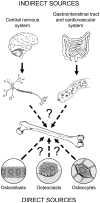Skeletal effects of serotonin (5-hydroxytryptamine) transporter inhibition: evidence from in vitro and animal-based studies
- PMID: 18622081
- PMCID: PMC4155922
Skeletal effects of serotonin (5-hydroxytryptamine) transporter inhibition: evidence from in vitro and animal-based studies
Abstract
The regulation of bone metabolism continues to be an area of intense investigation, with recent evidence indicating a potential contribution from the neural system. In particular, the neurotransmitter serotonin (5-hydroxytryptamine [5-HT]) has been hypothesized to play a role in skeletal metabolism via its transporter (5-HTT). The 5-HTT is a plasma membrane transporter that is highly specific for the uptake of extracellular 5-HT, thereby facilitating the intracellular storage and/or degradation of 5-HT. The 5-HTT is clinically important as it is the key target of pharmaceutical agents aimed at treating affective disorders, such as major depressive disorder. By antagonizing the 5-HTT, selective serotonin reuptake inhibitors (SSRIs) potentiate 5-HT activity and effectively relieve the symptoms of depression. However, questions have been raised regarding the potential skeletal effects of SSRIs given the recent identification of a functional 5-HTT and functional 5-HT receptors in bone cells. This paper discusses the preclinical evidence for the skeletal effects of 5-HT and the inhibition of the 5-HTT. In particular, it discusses the: (1) role of 5-HT and the function of the 5-HTT; (2) presence of functional 5-HTTs in bone; (3) potential sources and response mechanisms for 5-HT in bone, and; (4) in vitro and in vivo skeletal effects of 5-HT and 5-HTT inhibition.
Figures



Similar articles
-
The emerging role of serotonin (5-hydroxytryptamine) in the skeleton and its mediation of the skeletal effects of low-density lipoprotein receptor-related protein 5 (LRP5).Bone. 2010 Jan;46(1):4-12. doi: 10.1016/j.bone.2009.06.029. Epub 2009 Jul 8. Bone. 2010. PMID: 19591966 Free PMC article. Review.
-
[Effect of SSRIs on bone metabolism].Encephale. 2014 Feb;40(1):56-61. doi: 10.1016/j.encep.2013.04.007. Epub 2013 Jun 28. Encephale. 2014. PMID: 23810751 Review. French.
-
Skeletal effects of serotonin (5-hydroxytryptamine) transporter inhibition: evidence from clinical studies.J Musculoskelet Neuronal Interact. 2008 Apr-Jun;8(2):133-45. J Musculoskelet Neuronal Interact. 2008. PMID: 18622082 Review.
-
Depression, selective serotonin reuptake inhibitors, and osteoporosis.Curr Osteoporos Rep. 2010 Dec;8(4):185-91. doi: 10.1007/s11914-010-0026-z. Curr Osteoporos Rep. 2010. PMID: 20809204 Review.
-
Altered expression and functions of serotonin 5-HT1A and 5-HT1B receptors in knock-out mice lacking the 5-HT transporter.Eur J Neurosci. 2000 Jul;12(7):2299-310. doi: 10.1046/j.1460-9568.2000.00126.x. Eur J Neurosci. 2000. PMID: 10947809
Cited by
-
Psychotropic drugs have contrasting skeletal effects that are independent of their effects on physical activity levels.Bone. 2010 Apr;46(4):985-92. doi: 10.1016/j.bone.2009.12.031. Epub 2010 Jan 6. Bone. 2010. PMID: 20060080 Free PMC article.
-
Exploring the Role of Serotonin as an Immune Modulatory Component in Cardiovascular Diseases.Int J Mol Sci. 2023 Jan 12;24(2):1549. doi: 10.3390/ijms24021549. Int J Mol Sci. 2023. PMID: 36675065 Free PMC article. Review.
-
Use of antidepressant medications and risk of fracture in older women.Calcif Tissue Int. 2011 Jun;88(6):476-84. doi: 10.1007/s00223-011-9481-5. Epub 2011 Apr 1. Calcif Tissue Int. 2011. PMID: 21455735 Free PMC article.
-
The emerging role of serotonin (5-hydroxytryptamine) in the skeleton and its mediation of the skeletal effects of low-density lipoprotein receptor-related protein 5 (LRP5).Bone. 2010 Jan;46(1):4-12. doi: 10.1016/j.bone.2009.06.029. Epub 2009 Jul 8. Bone. 2010. PMID: 19591966 Free PMC article. Review.
-
The complex interplay of depression and falls in older adults: a clinical review.Am J Geriatr Psychiatry. 2013 May;21(5):484-92. doi: 10.1016/j.jagp.2013.01.008. Epub 2013 Feb 6. Am J Geriatr Psychiatry. 2013. PMID: 23570891 Free PMC article. Review.
References
-
- Patel MS, Elefteriou F. The new field of neuroskeletal biology. Calcif Tissue Int. 2007;80:337–47. - PubMed
-
- Warden SJ, Bliziotes MM, Wiren KM, Eshleman AJ, Turner CH. Neural regulation of bone and the skeletal effects of serotonin (5-hydroxytryptamine) Mol Cell Endocrinol. 2005;242:1–9. - PubMed
-
- Mach DB, Rogers SD, Sabino MC, Luger NM, Schwei MJ, Pomonis JD, et al. Origins of skeletal pain: sensory and sympathetic innervation of the mouse femur. Neuroscience. 2002;113:155–66. - PubMed
-
- Baldock PA, Sainsbury A, Allison S, Lin EJ, Couzens M, Boey D, et al. Hypothalamic control of bone formation: distinct actions of leptin and y2 receptor pathways. J Bone Miner Res. 2005;20:1851–7. - PubMed
